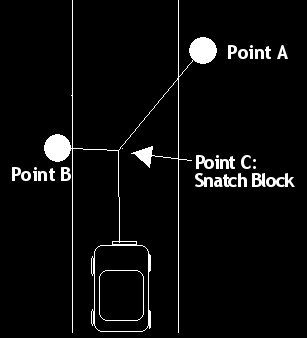Winches Part 3: How to use a Winch
This is the last of our three part article on Winches. Read more about how to choose your Winch or how to fit your Winch. Winching is a fairly technical discipline, and takes from practise to work effectively. If you don't do it right, you could end up damaging the vehicle or yourself. This article is a rough guide to Winching techniques.
Things you need
- Thick leather work gloves - You must always use these when winching. Steel cables have a tendency to splinter and these splinters will tear your hands to shreds without them. Preferably keep two or three pairs in a kit bag so you have a fresh pair for when the first pair get soaked in water, mud, snow and ice. It is always safer and easier to work with warm dry hands.
- A tree strop - You need this to put around a tree to connect your winch cable to. I have seen people put their winch cable around a tree and back on to itself - this should NEVER be done! First it will cause a kink in the cable and create a weak point and break strands of the cable, causing splinters. At the very least it will ruin an expensive cable. At worst it could break the cable, and the kinetic energy built up and released when a cable breaks can kill. That's why I prefer to use synthetic rope. It is more expensive compared to steel rope but it will last a lot longer with care and is a lot more user friendly. It also does not store up any kinetic energy when under load so does not flail about should it break. Also, without a tree strop a steel cable will cut in to the tree damaging it if not killing it.
- Shackles - Two minimum plus a spare. These are the way you connect all your accessories together.
Other useful items: a snatch block, choke chain, ground anchor, an extension cable and extra strops to reach just that little bit farther.
Winching Techniques
 Contrary to common sense, it is not just a matter of hooking it on to the nearest tree and winching yourself out of the hole you are in. Most importantly, you need to pull in a straight line to keep the cable running smoothly and evenly on the drum. Letting the cable cross over itself will cause it to crush and kink itself, causing splinters and weak spots and ruining the cable.
Contrary to common sense, it is not just a matter of hooking it on to the nearest tree and winching yourself out of the hole you are in. Most importantly, you need to pull in a straight line to keep the cable running smoothly and evenly on the drum. Letting the cable cross over itself will cause it to crush and kink itself, causing splinters and weak spots and ruining the cable.
The usual scenario is that your best anchor point is off to one side. In this case you need a second anchor point where you put your choke chain and snatch block.
Imagine you are driving down a forest track and have got stuck. The trees are all off to the sides of the track. A possible solution presents itself in the diagram. Point (A) is your main anchor. Point (B) is the anchor for your choke chain and (C) is your snatch block.
Run the cable through the snatch block at the second point and on to the main anchor point, and then adjust the position of the snatch block with the choke chain to bring the winch cable into line with the drum of the winch to give you a straight pull.
Another use for the snatch block is to attach it to your tree strop at the chosen anchor point and back to your vehicle by doubling the rope. This in effect halves the line speed and doubles your pulling power, also putting less strain on the winch. A big help on a really bogged down vehicle.
Ground Anchors - Winching with no trees
A typically valid question about winches is "what good is a winch if there is nothing to connect it to?" The answer is a ground anchor. There are several different types, some good, some heavy and some a waste of good money.
The large heavy one used by a lot of the top winch challenge competitors looks like a boat anchor with a long arm. As you winch it in, the two plough blades that are set at a angle dig in to the ground. The harder you pull the deeper it goes. This works well in competition but is too bulky and heavy for every day use.
There is a very fancy folding one on the market: this comes under the category of expensive scrap metal. I tried one once. The first time I used it, the blades dug in to the ground fine but hit an obstacle and veered off to the side while the top half stayed in line with the winch, twisting the whole lot in to scrap metal.
This leaves the two types I would recommend for every day use:
- The first type has three large metal T-shaped posts about a meter long, sharpened to a point at one end with a plate on the other end and a steel bar cross piece. You also need three tree strops. Attach on end of the first strop to the winch and the other end to the first post, which is hammered into the ground at a angle. This first strop should stay at ground level. The next strop should then be attached to the top of the first post and the other end should have the second post through it at a angle, and the same again with the third strop and post. By rigging your posts and strops like this it gives a leverage effect on the posts.
- The second type is a metal plate or series of metal plates with holes in that you hammer in spikes at angles. The plate has in effect been nailed to the floor; attach your winch to the plate and start pulling. Simple and effective.
There are some good examples of different ground anchors at Forgetec 4x4.
Removing your Ground Anchor
When using a ground anchor, you have the problem of getting your anchor out of the ground once you have recovered yourself. With the first type of recommended anchor, before you use it you should connect a strop to the back end of the anchor so that once you have freed yourself and got past the anchor you can hook the strop on to the back of your vehicle and drag the anchor out of the ground as it can go down some way in soft soil. The second type you need to remember not to knock them in so far that you can't hit the under side of the top plate with your hammer to get them out.
I hope you've enjoyed our three part series on Winching. If you have any more ideas or knowledge you would like to share, please get in contact. Many thanks to Wildrovers for these Winching articles.
